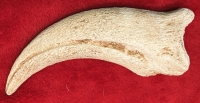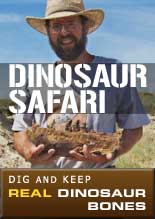
Spinosaurus probably had over 70 straight conical teeth that lacked serrations. They also varied greatly in size and length. Most of the teeth found are under 3 inches long without the root. However, a few teeth up to 12 inches long including the root have been found.
Spinosaurus was the biggest of all the carnivorous dinosaurs, larger than Tyrannosaurus and Giganotosaurus. It lived during part of the Cretaceous period, about 112 million to 97 million years ago, roaming the swamps of North Africa. Spinosaurus was first discovered in the early 1900's by German paleontologist Ernst von Stromer. During the second World War, Allied bombs inadvertently destroyed the only significant remains of the sail-backed predator.
Two Spinosaurus species have been named based on the regions where they were discovered: Spinosaurus aegyptiacus Egyptian spine lizard) and Spinosaurus maroccanus (Moroccan spine lizard).
HOW BIG WAS SPINOSAURUS
In a 2005 study in the Journal of Vertebrate Paleontology, researchers estimated Spinosaurus was 52 to 59 feet (16 to 18 m) long and weighed 7.7 to 9.9 tons (7 to 9 metric tons), based on extrapolations from skull measurements. However, other scientists took issue with the study's methods, and instead claimed the behemoth was 41 to 47 feet (12.6 to 14.3 m) long and 13.2 to 23 tons (12 to 20.9 metric tons), according to a 2007 study in the same journal. The partial Spinosaurus skeleton Ibrahim his colleagues analyzed suggests the specimen was 50 feet (15.2 m) long and still growing
Spinosaurus means "spine lizard," an appropriate descriptor, as the dinosaur had very long spines growing on its back to form what is referred to as a "sail." The distinctive spines, which grew out of the animal's back vertebrae, were up to 7 feet (2.1 meters) long and were likely connected to one another by skin.
Recent fossil evidence shows Spinosaurus was the first dinosaur that was able to swim, and likely spent most of its life in the water, according to a study published September 2014 in the journal Science. "Spinosaurus had short hind limbs (like early whales and other animals that spent more and more time in the water), dense and compact bones (penguins show a similar bone profile in cross section), wide and flat claws and feet (possibly used in paddling), and a long and slender snout with conical teeth (perfect for catching fish)," said Nizar Ibrahim, a University of Chicago vertebrate paleontologist and lead author of the study.
solid resin
9 inches
Item 2111
Category: Replicas
Type: Claws
Phylum: Vertebrates
Class: Dinosaurs
MORE PHOTOS:



Now Over 1,000 Items!
PrehistoricStore.com offers the largest selection of replica fossils and other fossil-related products anywhere in the world!
Download a Full Catalog (3MB PDF)
OVER 260 PAGES OF REPLICAS AND MORE!
